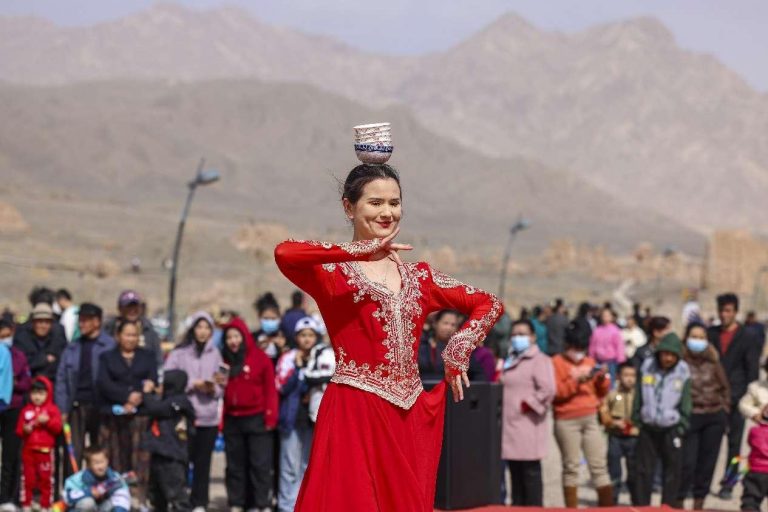
Kuqa city in Aksu prefecture, northwest China’s Xinjiang Uygur autonomous region, was known as Kucha in ancient times. It was home to the Anxi Protectorate, or the Protectorate to Pacify the West, in the Tang Dynasty (618-907), as well as an important transportation hub along the ancient Silk Road.
As one of the historical and cultural cities that boast the longest history and richest historical and cultural relics in Xinjiang, Kuqa is hailed as an “open-air museum.”
In recent years, the city has leveraged its local features and adopted innovative approaches to promote the protection and utilization of its historical resources, managing to preserve its historical charm while effectively utilizing its resources.
With a history of over 2,000 years, Kuqa is home to numerous historical, artistic, and scientific treasures, including ancient dwellings and old buildings. The local government has been committed to the restoration of culturally significant old houses.
In 2023, Kuqa launched a campaign to “save the old houses,” in which Tsinghua Heritage Institute for Digitization (THID), a Beijing-based institute focusing on the conservation, interpretation, presentation, digitization, and communication of cultural heritage, conducted a comprehensive survey of all ancient dwellings in the old towns of the city.
The campaign invited renowned Chinese experts in cultural heritage conservation to train local traditional craftsmen, so as to improve their skills, pass down traditional techniques, and provide support to the restoration and preservation of ancient dwellings.
He Yan, a cultural heritage conservation expert and THID director, told People’s Daily that the campaign has been joined by more than 150 local traditional craftsmen since its launch.
“This campaign follows the principle of minimal intervention, using original craftsmanship and materials for restoration. It also adopts targeted repair methods based on the value, cultural environment, and historical significance of each old house,” He explained.
Gen-Zer Yusupjan Asen returned to his hometown after graduating from university last year. Upon learning about the campaign, he immediately signed up for it as he had learned woodworking from his father since childhood.
“As witnesses to history and carriers of culture, ancient dwellings bear the historical memory of ethnic integration. It was my first formal experience in old house restoration, and I realized that it is quite challenging to repair houses, especially ancient dwellings. We needed to ensure safety while preserving the traditional patterns, designs, and styles,” said Yusupjan Asen.
In the Sakesake neighborhood, Kuqiairike community of Kuqa, there is a Kucha Alley, which exudes the folk charm of ethnic minorities at every turn, such as the umbrellas made of Etles silk hung above residential houses and the vibrantly patterned doors of these houses, drawing in visitors from near and far.
Kuqa boasts five historical and cultural blocks, and since 2023, the city has ramped up efforts to upgrade them. Taking a “renovation without demolition” approach, the city revitalized these historical areas by improving basic infrastructure like water and power supply, while also cultivating hubs for cultural tourism and shopping.
Mairan Nur runs a grocery shop in the Kucha Alley. “The environment here has really improved. There are more tourists nowadays. Coffee shops and bubble tea shops have opened up, and many locals have set up stalls or businesses right outside their houses,” Mairan Nur told People’s Daily.
Kuqa sanam, an ethnic music and dance widespread among the Uygur people in Kuqa, has been listed as a national-level intangible cultural heritage item. It is a demanding dance with stringent requirements. In the 1990s, as the older generation of dancers passed away, the inheritance of this art form encountered challenges.
Local authorities redoubled their efforts to protect intangible cultural heritage, emphasizing the importance of identifying, studying, preserving, and inheriting these traditions. This rekindled enthusiasm and passion for learning and performing the dance among the youth. In 2012, Nasir Nusur, a folk dancer from Kuqa, was recognized as a national-level inheritor of Kuqa sanam. To date, he has trained over 500 apprentices, breathing new life into this precious dance art.
This is just one example among many. In recent years, Kuqa has made tremendous efforts to preserve its intangible cultural heritage. The region now boasts 146 intangible cultural heritage items, including two at the national level, and there are over 500 inheritors of them. Local authorities have boosted the enthusiasm of these inheritors through dedicated funding, performances, and subsidies. Additionally, a master-apprentice model is attracting more and more young people to join the ranks of cultural preservation.










